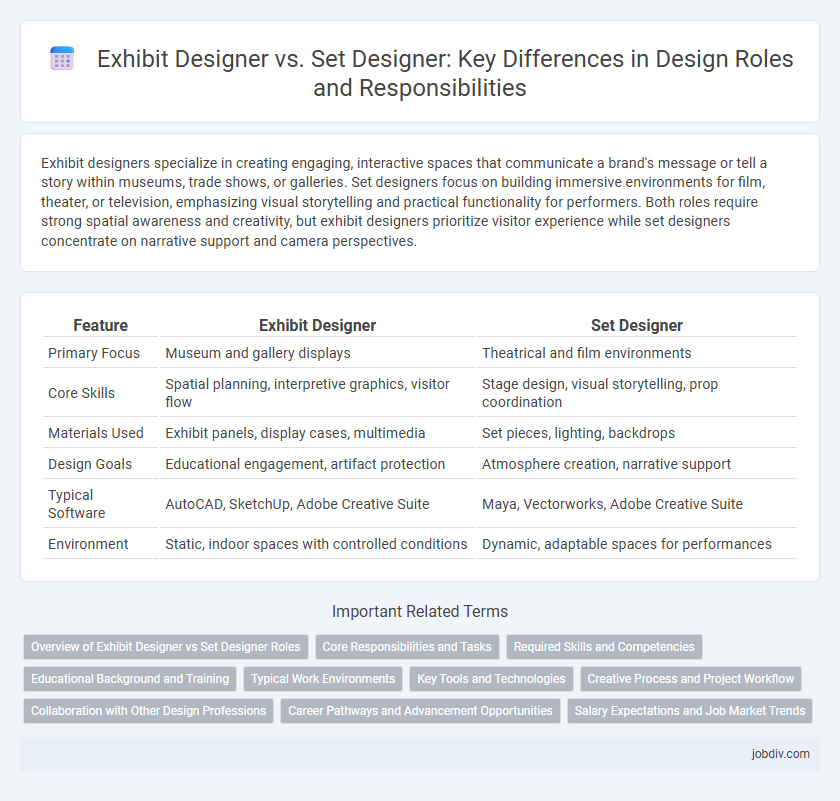Exhibit designers specialize in creating engaging, interactive spaces that communicate a brand's message or tell a story within museums, trade shows, or galleries. Set designers focus on building immersive environments for film, theater, or television, emphasizing visual storytelling and practical functionality for performers. Both roles require strong spatial awareness and creativity, but exhibit designers prioritize visitor experience while set designers concentrate on narrative support and camera perspectives.
Table of Comparison
| Feature | Exhibit Designer | Set Designer |
|---|---|---|
| Primary Focus | Museum and gallery displays | Theatrical and film environments |
| Core Skills | Spatial planning, interpretive graphics, visitor flow | Stage design, visual storytelling, prop coordination |
| Materials Used | Exhibit panels, display cases, multimedia | Set pieces, lighting, backdrops |
| Design Goals | Educational engagement, artifact protection | Atmosphere creation, narrative support |
| Typical Software | AutoCAD, SketchUp, Adobe Creative Suite | Maya, Vectorworks, Adobe Creative Suite |
| Environment | Static, indoor spaces with controlled conditions | Dynamic, adaptable spaces for performances |
Overview of Exhibit Designer vs Set Designer Roles
Exhibit designers specialize in creating engaging, informative displays for museums, galleries, and trade shows, emphasizing visitor interaction and educational content. Set designers focus on crafting physical environments for theater, film, and television, prioritizing storytelling and visual atmosphere to support performances. Both roles require spatial awareness and creativity but differ in objectives, with exhibit designers aiming for immersive educational experiences and set designers enhancing narrative and mood.
Core Responsibilities and Tasks
Exhibit designers specialize in creating engaging, functional displays for museums, trade shows, and galleries, focusing on visitor experience, spatial layout, and interactive elements. Set designers develop theatrical or film environments, emphasizing mood, narrative support, and technical feasibility within performance spaces. Both roles require collaboration with artists, architects, and production teams to ensure the design aligns with project goals and audience engagement.
Required Skills and Competencies
Exhibit designers require strong skills in spatial planning, graphic design, and interactive technology to create engaging and educational displays that enhance visitor experience. Set designers focus on competencies in theatrical design, construction techniques, and lighting to create immersive environments that support narrative storytelling on stage or screen. Both roles demand creativity, attention to detail, and proficiency in design software, but exhibit designers emphasize public interaction while set designers prioritize dramatic impact.
Educational Background and Training
Exhibit designers often hold degrees in graphic design, architecture, or museum studies, with specialized training in spatial storytelling and interactive displays. Set designers typically pursue education in theater arts, production design, or interior design, emphasizing skills in stagecraft, lighting, and materials. Both fields require hands-on experience through internships or apprenticeships to master technical tools and creative collaboration.
Typical Work Environments
Exhibit designers typically work in museums, galleries, trade shows, and corporate environments where they create interactive and educational displays. Set designers primarily operate in theaters, film studios, and television production companies, focusing on crafting immersive visual backdrops for performances and media. Both roles often require collaboration with multidisciplinary teams, including architects, engineers, and artists, to ensure functionality and aesthetic appeal in their respective spaces.
Key Tools and Technologies
Exhibit designers primarily utilize CAD software, 3D modeling tools like SketchUp, and virtual reality platforms to create immersive, interactive displays tailored for museums and trade shows. Set designers rely heavily on drafting software, lighting design tools such as Vectorworks Spotlight, and stage automation technology to craft functional and visually compelling theatrical environments. Both professions integrate physical prototyping and digital visualization techniques to ensure precision and enhance creative execution.
Creative Process and Project Workflow
Exhibit designers focus on creating immersive, interactive experiences that communicate specific messages or themes through spatial storytelling, incorporating graphics, lighting, and technology to engage audiences within museums, galleries, or trade shows. Set designers concentrate on crafting physical environments that support narrative and performance for theater, film, or television, emphasizing mood, character, and dramatic effect through detailed props, backdrops, and spatial arrangement. Both roles require iterative collaboration with clients, directors, and technical teams, but exhibit designers prioritize visitor flow and educational goals, while set designers emphasize visual impact and functional dynamics within a scripted production.
Collaboration with Other Design Professions
Exhibit designers collaborate closely with graphic designers, lighting specialists, and architects to create immersive and informative displays that enhance visitor engagement through cohesive visual storytelling. Set designers work alongside costume designers, sound engineers, and directors to develop theatrical environments that support narrative flow and actor movement. Both roles require seamless communication and interdisciplinary teamwork to integrate diverse design elements effectively within their respective spaces.
Career Pathways and Advancement Opportunities
Exhibit designers typically advance by specializing in museum curation, trade show production, or experiential marketing, gaining skills in spatial planning, storytelling, and interactive technology. Set designers often progress through theater, film, or television industries, enhancing expertise in lighting, prop integration, and collaborative production management. Career pathways for both roles emphasize portfolio development, technical proficiency, and networking within creative sectors to unlock senior design and directorial positions.
Salary Expectations and Job Market Trends
Exhibit designers typically earn between $55,000 and $85,000 annually, reflecting steady demand driven by museums, trade shows, and corporate events, whereas set designers in film, theater, and television often have a wider salary range from $45,000 to $100,000 depending on project scale and location. Job market trends indicate increasing opportunities for exhibit designers due to growth in experiential marketing and interactive spaces, while set designers face fluctuating demand tied closely to entertainment industry budgets and production cycles. Both roles require specialized skills, but exhibit design benefits from expanding digital integration, potentially boosting future salary growth and employment stability.
Exhibit Designer vs Set Designer Infographic

 jobdiv.com
jobdiv.com